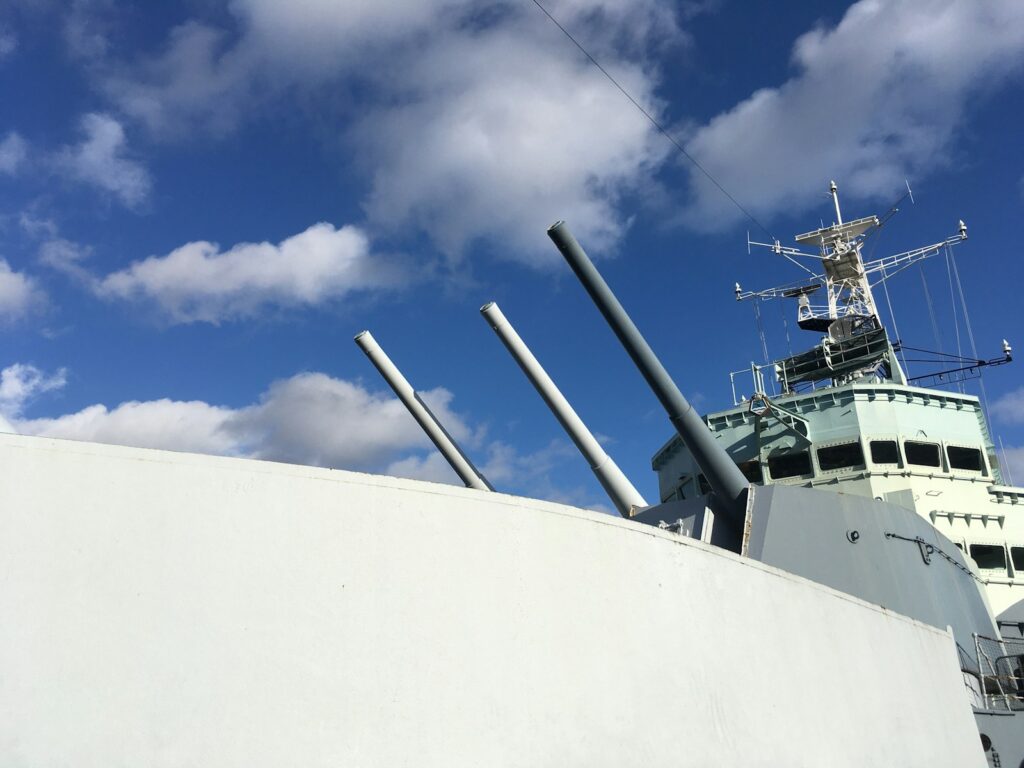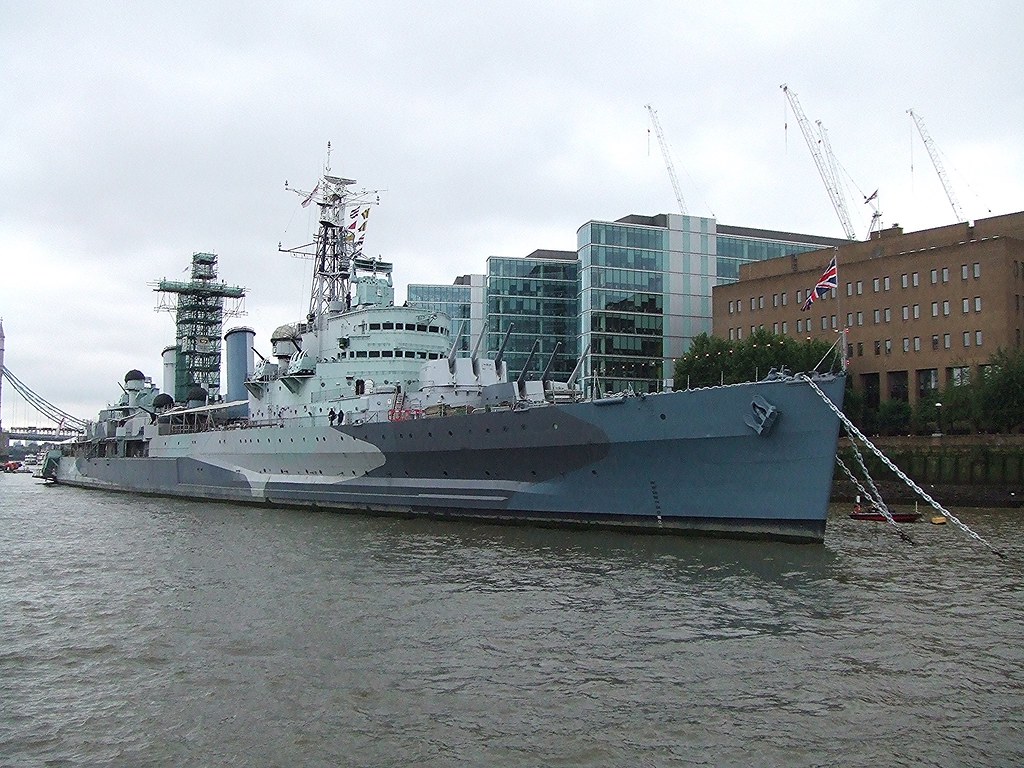Nestled on the banks of the Thames, near the iconic Tower Bridge, HMS Belfast invites visitors on a unique journey through Britain’s naval history. As a part of the Imperial War Museums, this historic warship offers a vivid glimpse into life at sea during the tumultuous times of World War II and the Korean War. My visit to HMS Belfast was not just a walk through a museum; it was a step back in time, an immersive experience that brought history to life before my eyes.
The Living History of HMS Belfast
HMS Belfast, a majestic warship moored on the River Thames, boasts a storied past that intertwines with some of the most pivotal events of the 20th century. Launched on St. Patrick’s Day in 1938, this Town-class light cruiser was among the largest and most powerful vessels in the Royal Navy at the outset of World War II. What makes HMS Belfast particularly fascinating is its survival from a mine explosion in 1939, which nearly spelled the end of its service. The damage was so severe that it took nearly three years of repairs before the ship could rejoin the war effort. This early brush with destruction only adds to the ship’s mystique, highlighting its resilience and the crucial role it would go on to play in naval history.
During World War II, HMS Belfast was a formidable presence, participating in the Arctic Convoys that delivered essential supplies to the Soviet Union—an endeavor Winston Churchill described as the “worst journey in the world.” The ship’s most celebrated moment, however, came on June 6, 1944, during the D-Day landings. Belfast played a pivotal role in Operation Neptune, the naval component of the Normandy invasion, by bombarding German defenses and clearing the way for Allied troops to land on the beaches. The precision and effectiveness of Belfast’s gunfire support were instrumental in the operation’s success, underscoring the ship’s vital contribution to one of the war’s most significant turning points.
But HMS Belfast’s service didn’t end with the conclusion of World War II. The ship was also actively involved in the Korean War from 1950 to 1952, patrolling the waters and providing naval gunfire support. This period of service is less known but equally significant, showcasing the ship’s versatility and enduring importance in post-war conflicts. The fact that Belfast was one of the first ships to arrive at the scene of the Korean War and served three tours of duty there is a testament to its reliability and the high regard in which it was held by the Royal Navy.
Today, HMS Belfast serves as a floating museum, part of the Imperial War Museums, and stands as a testament to Britain’s naval heritage. Its transformation from an active warship to a museum in 1971 was driven by a desire to preserve the ship for future generations, making its rich history accessible to all. Visitors can explore the nine decks of this historic vessel, from the engine rooms to the gun turrets, each telling a different part of its fascinating story. The ship’s longevity, having seen action in both World War II and the Korean War, and its subsequent preservation, offers a unique window into the past, inviting those who board it to step back in time and experience the life of a sailor on one of the Royal Navy’s most storied ships.

Navigating the Ship
Visiting HMS Belfast is an adventure in itself, but it does come with its challenges. The tight spaces and steep staircases are a testament to the realities of life at sea, making it essential to wear comfortable, sturdy shoes and travel light. The ship’s design, while authentic, may not be fully accessible to everyone, so it’s worth considering this when planning your visit.
The museum offers an audio guide, which I found invaluable during my visit. It provided fascinating insights into the ship’s history, its crew, and the broader context of the conflicts it participated in. The audio guide enriched the experience, making the stories of HMS Belfast come alive in a way that static exhibits alone could not.
Practical Information for Visitors
HMS Belfast invites visitors to explore its historic decks and corridors every day from 10:00 AM to 5:00 PM, offering a unique glimpse into naval warfare and life at sea. Adult tickets are priced around £16, with concessions available for children, families, and groups, ensuring access for all ages to this piece of living history. For those looking to avoid the crowds and enjoy a more intimate experience with the ship’s storied past, weekday mornings or late afternoons are ideal visiting times. A thorough exploration of HMS Belfast can take anywhere from 2 to 3 hours, allowing ample time to delve into the heart of the ship, from the engine rooms to the captain’s bridge. With its central location on the Thames, near the Tower Bridge, it’s a convenient and compelling addition to any London itinerary, promising an educational and memorable journey through time.
Tips for visiting HMS Belfast
Visiting HMS Belfast, moored on the River Thames and offering a deep dive into naval history, is an unforgettable experience. To ensure you make the most of your visit, here are five useful tips:
- Wear Comfortable Shoes: The ship’s layout includes narrow corridors, steep ladders, and tight spaces, typical of a warship. Comfortable, sturdy footwear is essential to safely navigate the vessel and enjoy the exploration without discomfort.
- Travel Light: With the confined spaces and the need to climb ladders between decks, it’s best to avoid bulky bags or heavy backpacks. If possible, bring only essentials to keep your hands free and make moving around easier.
- Use the Audio Guide: The audio guide available at HMS Belfast provides invaluable insights into the ship’s history, the daily life of its crew, and the roles it played in various conflicts. It enriches the visit by adding context and depth to what you’re seeing, making the experience more engaging and educational.
- Plan Your Visit: Before arriving, check the HMS Belfast website for the latest information on opening hours, ticket prices, and any special events or closures. Planning your visit also involves considering the best time to go; mornings or weekdays can be quieter, offering a more relaxed experience.
- Prepare for Weather Conditions: Parts of the ship are exposed to the elements, so it’s wise to check the weather forecast and dress accordingly. Bring a raincoat or umbrella for wet days, and on sunny days, sunscreen and a hat can provide protection from the sun.
Bonus Tip: Engage with the Exhibits: HMS Belfast is more than just a ship; it’s a museum with a wealth of stories. Take the time to engage with the exhibits, read the informational plaques, and immerse yourself in the recreated scenes aboard the ship. This approach will greatly enhance your understanding and appreciation of what life was like for those who served on this historic vessel.
Conclusion: Who Should Visit HMS Belfast?
HMS Belfast is a must-visit for history enthusiasts, military buffs, and families looking for an educational and engaging day out. It offers a rare opportunity to step into the shoes of those who lived and served on one of Britain’s most significant warships. The ship’s rich history, combined with the immersive presentation of life at sea, makes it a captivating experience for visitors of all ages.
Whether you’re drawn to the technical aspects of naval warfare, interested in the personal stories of the crew, or simply looking for a unique perspective on London’s history, HMS Belfast delivers. It’s a testament to the courage, innovation, and spirit of those who served on her decks, and a visit promises not just a lesson in history, but a profound appreciation for the sacrifices made in the name of freedom and security.








